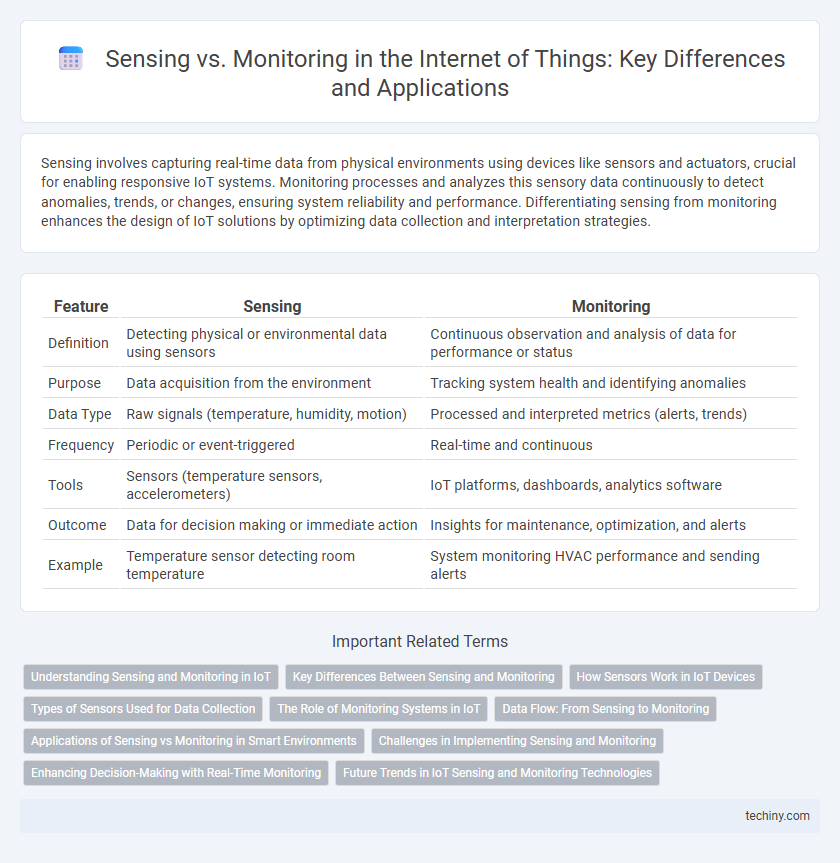Sensing involves capturing real-time data from physical environments using devices like sensors and actuators, crucial for enabling responsive IoT systems. Monitoring processes and analyzes this sensory data continuously to detect anomalies, trends, or changes, ensuring system reliability and performance. Differentiating sensing from monitoring enhances the design of IoT solutions by optimizing data collection and interpretation strategies.
Table of Comparison
| Feature | Sensing | Monitoring |
|---|---|---|
| Definition | Detecting physical or environmental data using sensors | Continuous observation and analysis of data for performance or status |
| Purpose | Data acquisition from the environment | Tracking system health and identifying anomalies |
| Data Type | Raw signals (temperature, humidity, motion) | Processed and interpreted metrics (alerts, trends) |
| Frequency | Periodic or event-triggered | Real-time and continuous |
| Tools | Sensors (temperature sensors, accelerometers) | IoT platforms, dashboards, analytics software |
| Outcome | Data for decision making or immediate action | Insights for maintenance, optimization, and alerts |
| Example | Temperature sensor detecting room temperature | System monitoring HVAC performance and sending alerts |
Understanding Sensing and Monitoring in IoT
Sensing in IoT involves collecting real-time data from the environment using sensors that detect physical parameters such as temperature, humidity, and motion. Monitoring refers to the continuous observation and analysis of this sensed data to identify patterns, anomalies, or trends for informed decision-making. Understanding the distinction between sensing and monitoring is crucial for designing effective IoT systems that optimize data accuracy and system responsiveness.
Key Differences Between Sensing and Monitoring
Sensing involves the direct detection and measurement of physical properties such as temperature, humidity, or motion using IoT sensors, creating raw data streams. Monitoring refers to the continuous observation and analysis of these sensor-generated data to assess system performance, detect anomalies, or trigger automated actions. The key difference lies in sensing being the initial data acquisition phase, while monitoring encompasses the ongoing interpretation and management of that data for operational decision-making.
How Sensors Work in IoT Devices
Sensors in IoT devices detect physical or environmental changes such as temperature, humidity, motion, or light through specialized components like thermistors, photodiodes, or accelerometers. These sensors convert analog signals into digital data via analog-to-digital converters, enabling real-time data processing and communication to IoT platforms. Monitoring relies on this continuous stream of sensor-generated data to analyze trends, trigger automated responses, or inform decision-making in smart systems.
Types of Sensors Used for Data Collection
Types of sensors used for data collection in Internet of Things (IoT) applications include temperature sensors, humidity sensors, pressure sensors, motion detectors, and optical sensors, each designed for specific sensing tasks. Sensing involves the direct measurement of physical or environmental parameters using these sensors, while monitoring refers to the continuous observation and analysis of this data to detect changes or anomalies over time. IoT systems integrate various sensor types to enable real-time data acquisition and facilitate intelligent decision-making processes.
The Role of Monitoring Systems in IoT
Monitoring systems in IoT continuously track and analyze data from interconnected sensors to ensure real-time visibility and operational efficiency across smart environments. These systems process sensor inputs to detect anomalies, predict failures, and enable proactive maintenance, enhancing overall system reliability. Effective monitoring leverages edge computing and cloud integration to optimize data flow and support scalable IoT deployments.
Data Flow: From Sensing to Monitoring
Sensing in the Internet of Things involves the initial capture of raw data through sensors embedded in devices, collecting environmental or operational parameters such as temperature, humidity, or motion. Monitoring processes this sensed data by aggregating, analyzing, and interpreting it in real-time to detect patterns, anomalies, or trends for decision-making and automated responses. Data flows from sensing to monitoring via wireless communication protocols like MQTT or Zigbee, ensuring seamless transmission and continuous feedback loops within IoT ecosystems.
Applications of Sensing vs Monitoring in Smart Environments
Sensing in smart environments involves real-time data collection from diverse IoT devices such as temperature sensors, motion detectors, and humidity gauges to enable immediate response and automation. Monitoring utilizes this sensed data by continuously analyzing environmental conditions, equipment status, and user behaviors to detect anomalies, optimize performance, and support decision-making processes. Applications of sensing include adaptive lighting and climate control, while monitoring supports predictive maintenance and security surveillance in smart homes, offices, and industrial settings.
Challenges in Implementing Sensing and Monitoring
Implementing sensing and monitoring in the Internet of Things (IoT) involves significant challenges such as ensuring sensor accuracy, managing vast data streams, and maintaining real-time data processing. Power consumption and device interoperability issues complicate the deployment of pervasive sensing networks. Security vulnerabilities and scalability concerns further hinder the seamless integration of sensing and monitoring systems within IoT infrastructures.
Enhancing Decision-Making with Real-Time Monitoring
Real-time monitoring in the Internet of Things collects continuous data streams from connected sensors, enabling dynamic analysis and immediate insights that improve decision-making accuracy. Unlike basic sensing, which only detects and transmits data, real-time monitoring integrates data processing and contextual interpretation to identify patterns and anomalies promptly. This proactive approach supports predictive maintenance, operational efficiency, and rapid response, enhancing strategic and tactical decisions across industries.
Future Trends in IoT Sensing and Monitoring Technologies
Emerging IoT sensing technologies leverage advanced AI algorithms and edge computing to enhance real-time data accuracy and reduce latency in environmental and industrial monitoring. Integration of 5G networks facilitates seamless communication between distributed sensors and centralized platforms, enabling scalable and efficient IoT ecosystems. Future trends emphasize the development of self-healing sensor networks and energy-harvesting devices to support sustainable, autonomous monitoring in smart cities and agriculture.
Sensing vs Monitoring Infographic

 techiny.com
techiny.com